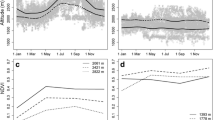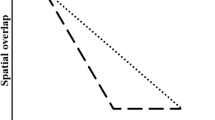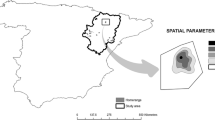Abstract
Despite the fact that investigations of home range behaviour have exponentially evolved on theoretical, analytical and technological grounds, the factors that shape animal home range behaviour still represent an unsolved question and a challenging field of research. However, home range studies have recently begun to be approached under a new integrated conceptual framework, considering home range behaviour as the result of the simultaneous influences of temporal, spatial and individual-level processes, with potential consequences at the population level. Following an integrated approach, we studied the influence of both external and internal factors on variations in the home range behaviour of 34 radiotagged eagle owl (Bubo bubo) breeders. Home range behaviour was characterised through complementary analysis of space use, movement patterns and rhythms of activity at multiple spatio-temporal scales. The effects of the different phases of the biological cycle became considerably evident at the level of movement patterns, with males travelling longer distances than females during incubation and nestling periods. Both external (i.e. habitat structure and composition) and internal (i.e. sex and health state) factors explained a substantial amount of the variation in home range behaviour. At the broader temporal scale, home range and core area size were negatively correlated with landscape heterogeneity. Males showed (1) smaller home range and core area sizes, (2) more complex home range internal structure and (3) higher rates of movement. The better the physiological condition of the individuals, the simpler the internal home range structure. Finally, inter- and intra-individual effects contributed to shaping space use and movement patterns during the biological cycle. Because of the plurality of behavioural and ecological processes simultaneously involved in home range behaviour, we claim that an integrative approach is required for adequate investigation of its temporal and spatial variation.

Similar content being viewed by others
References
Aebischer NJ, Robertson PA, Kenward RE (1993) Compositional analysis of habitat use from animal radio tracking data. Ecology 74:1313–1325. doi:10.2307/1940062
Anderson DP, Forester JD, Turner MG, Frair JL, Merrill EH, Fortin D, Mao JS, Boyce MS (2005) Factors influencing female home range sizes in elk (Cervus elaphus) in North American landscapes. Lands Ecol 20:257–271. doi:10.1007/s10980-005-0062-8
Bates DM, Sarkar D (2007) lme4: linear mixed-effects models using S4 classes, R package version 0.99875-6
Bell WJ (1991) Searching behaviour: the behavioural ecology of finding resources. Chapman and Hall, London
Börger L, Franconi N, Ferretti N, Meschi F, De Michele G, Gantz A, Coulson T (2006) An integrated approach to identify spatio-temporal and individual-level determinants of animal home range size. Am Nat 168:471–485
Börger L, Danziel BD, Fryxell JM (2008) Are there general mechanisms of animal home range behaviour? A review and prospects for future research. Ecol Lett 11:637–650. doi:10.1111/j.1461-0248.2008.01182.x
Both C, Dingemanse NJ, Drent PJ, Tinbergen JM (2005) Pairs of extreme avian personalities have highest reproductive success. J Anim Ecol 74:667–674. doi:10.1111/j.1365-2656.2005.00962.x
Burnham KP, Anderson DR (2002) Model selection and multi-model inference: a practical information-theoretic approach, 2nd edn. Springer, New York
Cagnacci F, Boitani L, Powell RA, Boyce MS (2010) Challenges and opportunities of using GPS-based location data in animal ecology. Philos Trans R Soc Lond B 365:2153–2312. ISSN 0962-8436
Calenge C (2006) The package adehabitat for the R software: a tool for the analysis of space and habitat use by animals. Ecol Mod 197:516–519. doi:10.1016/j.ecolmodel.2006.03.017
Costa FJV, Macedo RH (2006) Coccidian oocyst parasitism in the blueblack grassiquit: influence on secondary sex ornaments and body condition. Anim Behav 70:1401–1409. doi:10.1016/j.anbehav.2005.03.024
Cramp S, Simmons KEL (1977–1994) Birds of the western Palearctic, Oxford University Press, Oxford
Dalbeck L, Bergerhausen W, Krishner O (1998) Telemetriestudie zur Orts- und Partnertreue beim Uhu Bubo bubo. Vogelwelt 119:37–344
Darwin C (1861) On the origin of species by means natural selection, 3rd edn. Murray, London
De Solla SR, Bonduriansky R, Brooks RJ (1999) Eliminating autocorrelation reduces biological relevance of home range estimates. J Anim Ecol 68:221–234. doi:10.1046/j.1365-2656.1999.00279.x
Delgado MM, Penteriani V (2007) Vocal behaviour and neighbour spatial arrangement during vocal displays in eagle owl. J Zool 271:3–10. doi:10.1111/j.1469-7998.2006.00205.x
Delgado MM, Penteriani V (2008) Behavioral states help translate dispersal movements into spatial distribution patterns of floaters. Am Nat 172:475–485. doi:10.1086/590964
Delgado MM, Penteriani V, Nams O (2009) How fledglings explore surroundings from fledging to dispersal. A case study with eagle owls Bubo bubo. Ardea 97:7–15. doi:10.5253/078.097.0102
Delgado MM, Penteriani V, Revilla E, Nams VO (2010) The effect of phenotypic traits and external cues on natal dispersal movements. J Anim Ecol 79:620–632. doi:10.1111/j.1365-2656.2009.01655.x
Delibes M, Hiraldo F (1981) The rabbit as prey in the Iberian Mediterranean ecosystem. In: Myers K, Innes CD (eds) Proceedings of the World Lagomorph Conference 1979, University of Guelph, Ontario, pp 614–622
Delibes-Mateos M, Redpath SM, Angulo E, Ferreras P, Villafuerte R (2007) Rabbits as a keystone species in southern Europe. Biol Conserv 137:149–156. doi:10.1016/j.biocon.2007.01.024
Delibes-Mateos M, Ferreras P, Villafuerte R (2008) Rabbit populations and game management: the situation after 15 years of rabbit haemorrhagic disease in central-southern Spain. Biodiv Conserv 17:559–574. doi:10.1007/s10531-007-9272-5
Diffendorfer JE, Gaines MS, Holt RD (1995) Habitat fragmentation and movements of three small mammals (Sigmodon, Microtus, and Peromyscus). Ecology 76:827–839. doi:10.2307/1939348
Donázar JA, Ceballos O (1989) Selective predation by eagle owls Bubo bubo on rabbits Oryctolagus cuniculus: age and sex preferences. Ornis Scand 20:117–122
Donovan TM, Thompson FR, Faaborg J, Probst JR (1995) Reproductive success of migratory birds in habitat sources and sinks. Conserv Biol 9:1380–1395. doi:10.1046/j.1523-1739.1995.09061380.x
Elkie P, Rempel R, Carr A (1999) Patch analyst user’s manual: a tool for quantifying landscape structure. Ontario Ministry of Natural Resources Northwest Science and Technology. http://flash.lakeheadu.ca/_rrempe/patch/
Ferguson SH, Taylor MK, Born EW, Rosing-Asvid A, Messier F (1999) Determinants of home range size for polar bears (Ursus maritimus). Ecol Lett 2:311–318. doi:10.1046/j.1461-0248.1999.00090.x
Fernández N (2005) Spatial patterns in European rabbit abundance after a population collapse. Landsc Ecol 20:897–910. doi:10.1007/s10980-004-3976-7
Fernández N, Delibes M, Palomares F, Mladenoff DJ (2003) Identifying breeding habitat for the Iberian lynx: inferences from a fine-scale spatial analysis. Ecol Appl 13:1310–1324. doi:10.1890/02-5081
Fernández M, Oria J, Sánchez R, Gonzalez LM, Margalida A (2009) Space use of adult Spanish Imperial Eagles Aquila adalberti. Acta Ornithol 44:17–26. doi:10.3161/000164509X464849
Fortin D (2002) Optimal searching behaviour: the value of sampling information. Ecol Mod 153:279–290. doi:10.1016/S0304-3800(02)00031-5
Fraser DF, Gilliam JF, Daley MJ, Le AN, Skalski GT (2001) Explaining leptokurtic movement distributions: intrapopulation variation in boldness and exploration. Am Nat 158:124–135
González LM, Oria J, Sánchez R, Margalida A, Aranda A, Prada L, Caldera J, Molina JI (2008) Status and habitat changes in the endangered Spanish Imperial Eagle Aquila adalberti population during 1974–2004: implications for its recovery. Bird Conserv Int 18:242–259. doi:10.1017/S0959270908000245
Griffiths R, Double MC, Orr K, Dawson RJG (1998) A DNA test to sex most birds. Mol Ecol 7:1071–1075. doi:10.1046/j.1365-294x.1998.00389.x
Hayne DW (1949) Calculation of home range size. J Mammal 30:1–18
Hays G (2008) Virtual issue: biotelemetry and biologging. J Anim Ecol 77. http://www.journalofanimalecology.org/view/0/virtualissue1.html
Hinsley SA, Bellamy PE, Newton I, Sparks TH (1995) Habitat and landscape factors influencing the presence of individual breeding bird species in woodland fragments. J Avian Biol 26:94–104
Hooge PN, Eichenlaub B (2000) Animal movement extension to ArcView, version 2.0.3. Biological Science Centre, US Geological Survey, Anchorage, Alaska. http://www.absc.usgs.gov/glba/gistools/index.htm
Horne JS, Garton EO, Rachlowa JL (2008) A synoptic model of animal space use: simultaneous estimation of home range, habitat selection, and inter/intra-specific relationships. Ecol Mod 214:338–348. doi:10.1016/j.ecolmodel.2008.02.042
Hothorn T, Bretz F, Westfall P (2009) multcomp: simultaneous inference for general linear hypotheses. http://CRAN.R-project.org/package=multcomp. R package version 1.0-7
Indermaur L, Gehring M, Wehrle W, Tockner K, Naef-Daenzer B (2009) Behavior-based scale definition for detecting individual space use: requirements of two amphibians. Am Nat 173:60–71
Kernohan BJ, Gitzen RA, Millspaugh JJ (2001) Analysis of animal space use and movements. In: Millspaugh JJ, Marzluff JM (eds) Radiotracking and animal populations. Academic, San Diego, pp 125–166
Kie JG, Bowyer RT, Nicholson MC, Boroski BB, Loft ER (2002) Landscape heterogeneity at differing scales: effects on spatial distribution of mule deer. Ecology 83:530–544
Kie JG, Matthiopoulos J, Fieberg J, Powell RA, Cagnacci F, Mitchell MS, Gaillard J-M, Moorcroft PR (2010) The home-range concept: are traditional estimators still relevant with modern telemetry technology? Phil Trans R Soc Lond B 365:2221–2231. doi:10.1098/rstb.2010.0093
Knick ST, Rotenberry JT (1995) Landscape characteristics of fragmented shrubsteppe habitats and breeding passerine birds. Conserv Biol 9:1059–1071
Lombardi L, Fernández N, Moreno S, Villafuerte R (2003) Habitat-related differences in rabbit (Oryctolagus cuniculus) abundance, distribution, and activity. J Mammal 84:26–36. doi:10.1644/1545-1542(2003)084<0026:HRDIRO>2.0.CO;2
Lombardi L, Fernández N, Moreno S (2007) Habitat use and spatial behaviour in the European rabbit in three mediterranean environments. Bas Appl Ecol 8:453–463. doi:10.1016/j.baae.2006.09.004
Lourenço R (2006) The food habits of Eurasian eagle-owls in Southern Portugal. J Raptor Res 40:297–300. doi:10.3356/0892-1016(2006)40[297:TFHOEE]2.0.CO;2
MacDonald DW, Barret P (1993) Mammals of Britain and Europe. Harper-Collins, London
Marquiss M, Newton I (1981) A radio-tracking study of the ranging behaviour and dispersion of European Sparrow hawks Accipiter nisus. J Anim Ecol 51:111–133
Martínez CJA, Zuberogoitia AI, Alonso MR (2002) Rapaces nocturnas. Guía para la determinación de la edad y el sexo en las estrigiformes ibéricas, 1st edn. Monticala, Madrid
McLoughlin PD, Ferguson SH (2000) A hierarchical pattern of limiting factors helps explain variation in home range size. Ecoscience 7:123–130
McNab BK (1963) Bioenergetic and the determination of home range size. Am Nat 97:133–140
Mora O, Delgado MM, Penteriani V (2010) Secondary sex ratio in Eurasian Eagle-owls: early-breeding females produce more daughters. J Raptor Res 44:62–65
Morales JM, Moorcroft PR, Matthiopoulos J, Frair JL, Kie JG, Powell RA, Merrill EH, Haydon DT (2010) Building the bridge between animal movement and population dynamics. Phil Trans R Soc Lond B 365:2289–2301. doi:10.1098/rstb.2010.0082
Nathan R, Getz WO, Revilla E, Holyoak M, Kadmon R, Saltz D, Smouse PE (2008) A movement ecology paradigm for unifying organism movement research. Proc Natl Acad Sci USA 105:19052–19059. doi:10.1073/pnas.0800375105
Palma L, Beja P, Rodrigues M (1999) The use of sighting data to analyse Iberian lynx habitat and distribution. J Appl Ecol 36:812–824
Palomares F (2001a) Comparison of 3 methods to estimate rabbit abundance in a Mediterranean environment. Wildl Soc Bull 29:578–585
Palomares F (2001b) Vegetation structure and prey abundance requirements of the Iberian lynx: implications for the design of reserves and corridors. J Appl Ecol 38:9–18. doi:10.1046/j.1365-2664.2001.00565.x
Palomares F, Dlibes M, Revilla E, Calzada J, Fedriani JF (2001) Spatial ecology of Iberian lynx and abundance of European rabbits in southwestern Spain. Wildl Monogr 148:1–36
Pasinelli G (2000) Oaks (Quercus sp.) and only oaks? Relations between habitat structure and home range size of the middle spotted woodpecker (Dendrocopos medius). Biol Conserv 93:227–235. doi:10.1016/S0006-3207(99)00137-8
Penteriani V, Delgado MM (2008a) Brood-switching in eagle owl Bubo bubo fledglings. Ibis 150:816–819. doi:10.1111/j.1474-919X.2008.00831.x
Penteriani V, Delgado MM (2008b) Owls may use faeces and prey feathers to signal current reproduction. PLoS One 3(8):e3014. doi:10.1371/journal.pone.0003014
Penteriani V, Delgado MM, Maggio C, Aradis A, Sergio F (2005) Development of chicks and pre-dispersal behaviour of young in the eagle owl Bubo bubo. Ibis 147:155–168. doi:10.1111/j.1474-919x.2004.00381.x
Penteriani V, Alonso-Alvarez C, Delgado MM, Sergio F (2007a) The importance of visual cues for nocturnal species: eagle owls signal by badge brightness. Behav Ecol 18:143–147. doi:10.1093/beheco/arl060
Penteriani V, Delgado MM, Alonso-Alvarez C, Viqueira Pina N, Sergio F, Bartolommei P (2007b) The importance of visual cues for nocturnal species: eagle Owl fledglings signal with white mouth feathers. Ethology 113:934–943. doi:10.1111/j.1439-0310.2007.01414.x
Penteriani V, Delgado MM, Maggio C, Alonso-Alvarez C, Holloway GJ (2008) Owls and rabbits: selective predation against substandard individuals by a sit-and-wait predator. J Avian Biol 39:215–221. doi:10.1111/j.0908-8857.2008.04280.x
Penteriani V, Delgado MM, Campioni L, Lourenço R (2010) Moonlight makes owls more chatty. PLoS One 5(1):e8696. doi:10.1371/journal.pone.0008696
Pinheiro JC, Bates DM (2004) Mixed-effects Models in S and S-PLUS. Springer, New York
Pinheiro JC, Bates DM, DebRoy S, Sarkar D, R Core team (2009) nlme: linear and nonlinear mixed effects models. R package version 3.1-90
R Development Core Team (2009) R: a language and environment for statistical computing. R Foundation for Statistical Computing, Vienna
Revilla E, Wiegand T, Palomares F, Ferreras P, Delibes M (2004) Effects of matrix heterogeneity on animal dispersal: from individual behavior to metapopulation-level parameters. Am Nat 164:130–153
Rivrud IM, Loe LE, Mysterud A (2010) How does local weather predict red deer home range size at different temporal scale? J Anim Ecol 79:1280–1295. doi:10.1111/j.1365-2656.2010.01731.x
Said S, Servanty S (2005) The influence of landscape structure on female roe deer home-range size. Landsc Ecol 20:1003–1012
Saïd S, Gaillard JM, Widmer O, Débias F, Bourgoin G (2009) What shape intra- specific variation in home range size? A case study of female roe deer. Oikos 118:1299–1306. doi:10.1111/j.1600-0706.2009.17346.x
Sasha RX, Houston AI, McNamara JM (2004) The behavioural ecology of personality: consistent individual differences from adaptive perspective. Ecol Lett 7:734–739. doi:10.1111/j.1461-0248.2004.00618.x
Schoener TW (1968) Size and feeding territories among birds. Ecology 49:123–141
Seaman DE, Powell RA (1996) An evaluation of the accuracy of Kernel density estimators for home range analysis. Ecology 77:2075–2085
Seaman DE, Millspaugh JJ, Kernohan BJ, Brundige GC, Raedeke KJ, Gitzen RA (1999) Effects of sample size on kernel home range estimates. J Wildl Manag 63:739–747
Selås V, Rafoss T (1999) Ranging behaviour and foraging habitats of breeding Sparrow hawks Accipiter nisus in a continuous forested area in Norway. Ibis 141:269–276. doi:10.1111/j.1474-919X.1999.tb07549.x
Silverman BW (1986) Density estimation for statistics and data analysis. Monographs on statistics and applied probability. Chapman and Hall, London
Smouse PE, Focardi S, Moorcroft PR, Kie JG, Forester JD, Morales JM (2010) Stochastic modelling of animal movement. Phil Trans R Soc Lond B 365:2201–2211. doi:10.1098/rstb.2010.0078
Stamps JA, Groothuis GG (2010) Developmental perspectives on personality: implications for ecological and evolutionary studies of individual differences. Phil Trans R Soc Lond B 365:4029–4041. doi:10.1098/rstb.2010.0218
Tufto J, Andersen R, Linnell JDC (1996) Habitat use and ecological correlates of home range size in a small cervid: the roe deer. J Anim Ecol 65:715–724
van Beest FM, Rivrud IM, Loe LE, Milner JM, Mysterud A (2011) What determines variation in home range sizes across spatiotemporal scales in a large browsing herbivore? J Anim Ecol 80:771–785. doi:10.1111/j.1365-2656.2011.01829.x
Worton BJ (1989) Kernel methods for estimating the utilization distribution in home range studies. Ecology 70:164–168. doi:10.2307/1938423
Zheng B, Agresti A (2000) Summarizing the predicted power of a generalized linear model. Stat Med 19:1771–1781. doi:10.1002/1097-0258(20000715)19:13<1771:AID-SIM485>3.0.CO;2-P
Zuur AF, Ieno EN, Walker NJ, Saveliev AA, Smith GM (2009) Mixed effects models and extensions in ecology with R. Springer, New York
Acknowledgments
We wish to thank P. Bartolommei, C. Bettega, B. Fant and C. Maggio for their help with fieldwork. We also are grateful to R. Alonso for his help in aging eagle owls. We thank Markku Orell and two anonymous referees for their helpful comments and improvements of the manuscript. The work was funded by two research projects of the Spanish Ministry of Science and Innovation (CGL2004-02780/BOS and CGL2008-02871/BOS; with FEDER co-financing), the Ministry of Education and Science—C.S.I.C. (Proyectos Intramurales Especiales, DG-2606-PC), the Junta of Andalucía (Excellence Project, RNM-5090), and LICOR43. During this work, L.C. was supported by the JAE pre-doctoral grant from the C.S.I.C., V.P. received a grant from the Spanish Secretaría General de Universidades, Ministry of Education (Salvador de Madariaga Program), and M.M.D. was recipient of a post-doctoral fellowship from the Spanish Ministry of Science and Innovation, and a post-doctoral grant from the Finnish Academy n° 140367. Owls were trapped and marked under the Junta de Andalucía–Consejería de Medio Ambiente permit nos. SCFFSAFR/GGG RS-260/02 and SCFFS-AFR/CMM RS-1904/02.
Author information
Authors and Affiliations
Corresponding authors
Additional information
Communicated by Markku Orell.
Electronic supplementary material
Below is the link to the electronic supplementary material.
Rights and permissions
About this article
Cite this article
Campioni, L., Delgado, M.d.M., Lourenço, R. et al. Individual and spatio-temporal variations in the home range behaviour of a long-lived, territorial species. Oecologia 172, 371–385 (2013). https://doi.org/10.1007/s00442-012-2493-7
Received:
Accepted:
Published:
Issue Date:
DOI: https://doi.org/10.1007/s00442-012-2493-7




